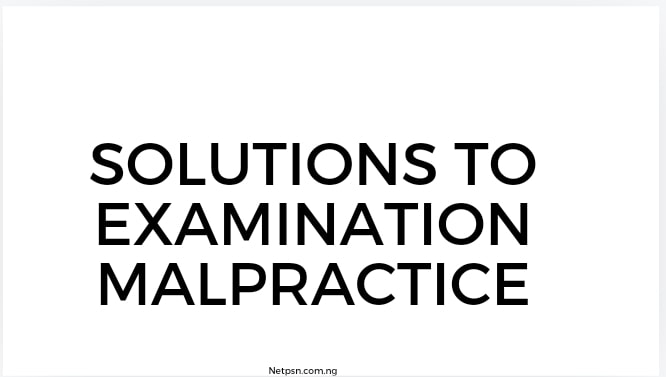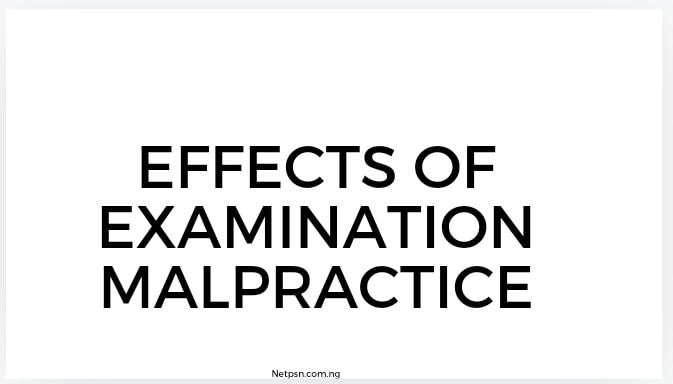Examination malpractice has become a widespread issue, affecting the integrity of educational systems around the world. Its negative impact spans students, institutions, and society as a whole, leading to a devaluation of academic achievements.
To combat this issue, several solutions have been proposed, and implementing these measures can help restore the credibility of examinations. This article explores effective solutions to Examination malpractice and promote academic honesty.
1. Enhancing Examination Security Measures
One of the primary ways to tackle examination malpractice is by improving the security around the administration of exams. Security breaches during exams often create opportunities for cheating. Strengthening these measures can include:
1.1 Use of Surveillance Systems
Installing surveillance cameras in examination halls can deter students from engaging in malpractice. These systems help monitor the activities of students and invigilators, ensuring no suspicious behavior goes unnoticed.
1.2 Biometric Identification
Introducing biometric systems for candidate identification can prevent impersonation during exams. Fingerprint or facial recognition technology can ensure that only registered students participate in the examinations, reducing identity fraud.
1.3 Randomized Seating Arrangements
Random seating during exams can minimize the chances of students collaborating. By assigning seats randomly on exam day, institutions can prevent students from planning how to share answers during the exam.
2. Raising Awareness and Promoting Ethical Values
Education systems should focus on creating awareness about the consequences of examination malpractice and the value of academic integrity.
2.1 Student Workshops on Integrity
Regular workshops and seminars on the importance of honesty and hard work can create an ethical environment in schools and universities. Students need to understand the long-term consequences of cheating, such as losing credibility and career opportunities.
2.2 Inclusion of Moral Education in Curriculum
Incorporating moral and ethical education into the academic curriculum helps to shape students’ perspectives on integrity. Teaching students the value of honesty from a young age reduces their inclination to engage in fraudulent behavior during exams.
3. Strengthening the Role of Invigilators
Invigilators play a critical role in preventing examination malpractice. By reinforcing their roles and ensuring they are well-trained, the likelihood of malpractice can be significantly reduced.
3.1 Training and Retraining Invigilators
Institutions should regularly train invigilators on the latest methods of cheating and how to detect them. Well-prepared invigilators can quickly identify suspicious behavior and take appropriate actions to curb malpractice.
3.2 Holding Invigilators Accountable
When invigilators are held accountable for the conduct of the examination hall, they are more likely to be vigilant. Institutions can implement a reporting system where invigilators are evaluated based on their performance during exams.
4. Leveraging Technology in Exam Management
The integration of technology in examination processes is another effective way to tackle malpractice.
4.1 Computer-Based Testing (CBT)
Computer-based tests can reduce the risk of exam malpractice by randomizing questions and answers for each student. With unique question papers, students cannot collaborate or copy from one another.
4.2 Online Proctoring Tools
For remote or online examinations, using proctoring tools with AI can detect unusual behavior such as looking away from the screen, unauthorized materials in the background, or multiple people in the room. This deters students from cheating during online exams.
5. Encouraging Student Accountability
Creating a culture of accountability among students can reduce their reliance on dishonest means to pass exams.
5.1 Honor Codes
Introducing honor codes that students must pledge to follow can have a profound impact on their behavior during exams. When students commit to maintaining integrity, they are less likely to engage in malpractice out of fear of breaking their own oath.
5.2 Peer Monitoring
Encouraging students to report malpractice when they witness it can create a self-regulating system. With peer pressure, students are less likely to cheat, knowing that their classmates may hold them accountable.
6. Enforcing Strict Penalties for Malpractice
Strict consequences for examination malpractice act as a powerful deterrent. When students are aware of the penalties, they may think twice before attempting to cheat.
6.1 Expulsion or Suspension
Institutions should enforce strict penalties such as suspension or expulsion for students found guilty of cheating. These actions serve as a warning to others and reinforce the message that examination malpractice will not be tolerated.
6.2 Legal Prosecution
In some cases, legal actions should be taken against severe forms of malpractice, such as impersonation or bribery. Prosecution under the law can discourage students and external agents from participating in fraudulent exam practices.
7. Parental and Societal Involvement
Parents and society play a vital role in shaping students’ attitudes towards examinations and academic performance.
7.1 Educating Parents on the Dangers of Malpractice
Parents should be informed about the risks associated with exam malpractice and how it affects their children’s future. By understanding these dangers, parents can discourage their children from engaging in cheating.
7.2 Public Campaigns on Academic Integrity
Public campaigns that promote academic honesty and discourage cheating can create a cultural shift. When society values hard work and frowns upon cheating, students are less likely to succumb to the pressure of examination malpractice.
Conclusion
Examination malpractice undermines the integrity of educational systems and devalues genuine academic efforts. However, through a combination of enhanced security measures, technology integration, ethical education, student accountability, strict penalties, and societal support, it is possible to significantly reduce the occurrence of malpractice.
Institutions, students, parents, and society must work together to uphold academic honesty and restore faith in the examination process.
Also Read: Effects of Examination Malpractice
FAQs
1. How can students be encouraged to avoid cheating during exams?
Students can be encouraged by promoting the importance of academic integrity, offering workshops on the consequences of cheating, and fostering a culture of accountability through honor codes and peer monitoring.
2. What role does technology play in reducing examination malpractice?
Technology plays a key role through computer-based testing, online proctoring tools, and biometric identification systems, all of which help secure the examination process and reduce opportunities for cheating.
3. Why is it important to enforce strict penalties for examination malpractice?
Strict penalties serve as a deterrent, making students think twice before engaging in cheating. When the consequences of malpractice are severe, students are less likely to take the risk.

















+ There are no comments
Add yours